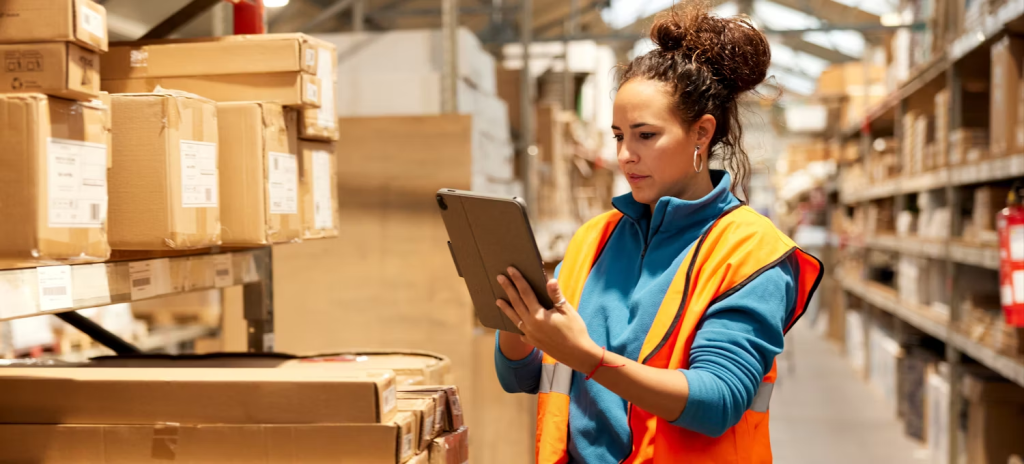Sustainable Inventory Management: The Role of Green Logistics Technologies
Sustainability is now a top priority for many companies. Businesses need to use resources efficiently and reduce their environmental impact at the same time. Sustainable inventory management and green logistics technologies make this possible. They help companies keep the right amount of stock, lower costs, and protect the environment.

1. What is Sustainable Inventory Management?
Sustainable inventory management focuses on maintaining the right amount of stock to meet customer demand while minimising waste, energy use, and carbon emissions. Unlike traditional approaches that emphasise only profitability, sustainable inventory management combines financial efficiency with environmental responsibility.
For example, holding too much stock increases storage space and energy consumption, while understocking leads to higher fuel usage and carbon footprints in emergency shipments. Therefore, balancing these factors is key to sustainable success.
2. How Green Logistics Technologies Support Sustainability
Real-Time Inventory Tracking
One major challenge in inventory management is a lack of visibility. Green logistics technologies use IoT sensors, barcodes, and RFID systems to provide real-time data on inventory levels, locations, and conditions. It reduces overstocking and prevents waste due to expiry or damage.
For instance, a company selling organic skincare products can monitor stock freshness and temperature in different warehouses.
AI-Based Demand Forecasting (AI Forecasting)

AI and advanced analytics analyze historical sales data, seasonal trends, and external factors to predict demand accurately. Better forecasts help businesses keep only the necessary stock, avoiding excess storage and reducing the resources needed for warehousing.
Additionally, by preventing last-minute urgent shipments due to stockouts, companies cut down on carbon emissions from express transport services.
Optimized Transportation
Transportation is a major contributor to greenhouse gas emissions in logistics. Green technologies such as transport management systems (TMS) optimize delivery routes based on traffic, distance, and vehicle capacity. This minimizes fuel consumption and reduces the environmental impact of inventory distribution.
For example, an e-commerce retailer can use TMS to consolidate deliveries and send fewer trucks on shorter routes, achieving both cost savings and sustainability goals.
Automated Replenishment Systems
Automated inventory systems trigger restocking orders when stock levels reach a set threshold. This ensures continuous availability without overstocking. It also enables businesses to schedule replenishments with eco-friendly suppliers or choose transport options with lower emissions, supporting a greener supply chain.
Circular Inventory Strategies

Sustainable inventory management includes reverse logistics to responsibly handle returned, damaged, or unused items. Green logistics technologies facilitate collection, refurbishment, recycling, or donation, extending product life cycles and reducing landfill waste.
For example, electronics companies often recover valuable metals from returned devices, minimizing the need for new mining activities that harm the environment.
3. Real-Life Example: PostalParcel’s Green Inventory Management
PostalParcel, a logistics platform specializing in cross-border fulfillment, demonstrates the power of green logistics technologies. Its integrated system combines IoT tracking, AI demand forecasting, and automated inventory transfers across warehouses in different countries.
Key sustainable features include:
- Dynamic Allocation: Orders are shipped from the nearest warehouse to customers, reducing transport distances and emissions.
- Efficient Transfers: When stock is low in one location, PostalParcel’s system initiates transfers from nearby warehouses rather than creating new purchase orders, reducing production demand and waste.
- Sustainable Partnerships: The platform works with carriers using electric vehicles for last-mile delivery and promotes eco-friendly packaging options to its e-commerce partners.
As a result, PostalParcel helps businesses manage inventory more sustainably while ensuring fast and reliable delivery services.
4. Future Trends in Green Inventory Management

Looking ahead, green logistics technologies will continue to evolve. We will see:
- Blockchain tracks product life cycles transparently, from raw materials to recycling.
- Electric autonomous vehicles for warehouse operations and last-mile deliveries.
- AI optimization algorithms that adjust stock levels dynamically based on live sales data and environmental factors.
These innovations will drive supply chains towards net-zero emissions goals while enhancing operational efficiency.
5. Conclusion
Sustainable inventory management helps businesses stay competitive and care for the environment. Green logistics technologies like real-time tracking, AI forecasting, automated restocking, and reverse logistics make inventory systems more eco-friendly and efficient. These solutions reduce carbon emissions and improve a company’s reputation with sustainability-conscious customers.
Industry Insights
news via inbox
Nulla turp dis cursus. Integer liberos euismod pretium faucibua








